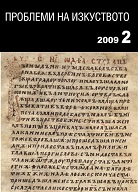Семантика и орнамент: методологически принос към изучаването на средновековната украса
Semantics and Ornament: An Essay in Methodology of Research of Medieval Decoration
Author(s): Branislav CvetkovićSubject(s): Cultural history
Published by: Институт за изследване на изкуствата, Българска академия на науките
Summary/Abstract: The author analyzes a range of ornamental motifs used in the well-known headpiece illustration painted at the beginning of the Synaxarion in the 13th c . Bulgarian manu- script Dobreysho’s Gospels, and the role of „ornament” in medieval art . With structure being made up of interlaces and of intertwined circles and palmettes, the head- piece has long been a matter of scholarly attention, due to inscription written above it: this is the heaven, also called paradise, which clarifies its meaning . In order to uncover the actual origin of the motifs, the author surveys a huge body of comparative material and scrutinizes existing methods in research of both function and sense of medieval and Byzantine ornament . The issue of terminology is firstly questioned, as being mirrored in free associations used in descriptions (headpieces as „carpets”), in unfounded typology (classification of ornaments as geometric, floral or animal), and in superficiality of „norms” (palmettes, acanthus, lily, etc) . Given the immense significance of etymology of terms denoting ornament in various languages, which has been traced in a number of scholarly works, the author puts forward his argument that the sense of „ornament” in a sacred context is not purely decorative, but that its basic role is to denote sacredness of a particular space and/or the constant presence of God . Various examples from all periods of Byzantine art corroborate the thesis, from manuscript illumination and wall paintings (Cappadocia, Russia, Balkans), to revetments and painted or mosaic backgrounds of icons . h . Kessler’s research of judaeo- Christian symbols-paradigms points to essential value of the Old Testament Tabernacle images from several manuscripts of Christian Topography in producing sources of symbolic motifs to appear in multiple later instances . Although not much varied, the motifs always form a structural unit (starry or flowery fields, interlace or diaper schemes, checkerboards) . They originate from the coffered ceilings of antique tombs and temples signifying heavens and Elysium, and reappear with identical forms in medieval art, firstly in painted ceilings of catacombs and on arches of Early Chris- tian basilicas .
Journal: Проблеми на изкуството
- Issue Year: 2009
- Issue No: 2
- Page Range: 3-9
- Page Count: 7
- Language: Bulgarian
- Content File-PDF

